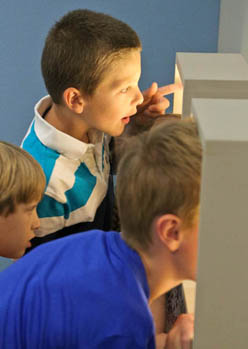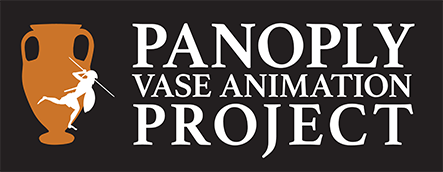You can use these animations to spark all sorts of teaching and learning activities. They’re particularly good for sessions on classical civilisation, art, drama, and creative writing. They can be used with learners of all ages and levels, from primary through to higher education as well as community, home-school, and lifelong learning. If you're not teaching a group, do the activities yourself or with your friends! This page contains ideas for how you can use the animations to liven up discussions about ancient Greece and as a springboard into creative activities.
Click here for a PowerPoint about Museum Curators and what they do.
Click here for a PowerPoint about Ancient Greek Gods and Goddesses.
Click here for a blank vase template.
Click here for a blank storyboard.
Click here for a guide to storyboarding.
Click here for our guide to vase shapes.
For more ideas and discussion take a look at our publications.
On each animation page you'll find suporting material and activities to go with the animation.
Sappho, Heracles and the Erymanthian Boar, Dionysus and Iris come with short documentaries that complement the animations.
Our blog features discussions of vases and iconography, interviews with leading academics, and news on our latest activities.

Topic Support
Teaching an Olympic topic? Show The Cheat and use it to brighten up your discussion of foot races, horse racing, nudity, cheating and fair-play, and to illustrate how much the Greeks loved to have athletics scenes on their vases. Use the filter on All Animations to help you find the topics that would be most useful to you.
Teaching literature? Use the animations to introduce characters or to add to discussions about characterisation. For example, in Clash of the Dicers, Ajax gets angry when he thinks Achilles isn’t playing fairly; use this as an accessible starting point for discussing Sophocles’ Ajax or The Iliad). Sappho features ancient poetry and offers a new way to think about the Trojan War.
Teaching drama? Show Dionysus to introduce the god and to explore staging and spectacle.
Teaching religion? Hoplites! features a hepatoscopy – divination through liver examination; Libation shows a ritual libation taking place. Many of the animations feature gods, goddesses and heroes – use them as a springboard into discussions of who the gods are and how they were depicted.
Teaching art history? Animations are a great way of encouraging students to notice small details and to think about proportion, realism, and stylisation. Compare Dance Off and The Procession to help to demonstrate the different effects of red and black figure vase-painting.
Benefits of showing vase animations in a teaching context:
- Accessible route into discussions
- Improved attention to and understanding of artefacts
- Animation linked to improved recall
- Informal activity linked with improved mood, related to increased learning

Storyboarding
Storyboarding is a great activity. Get your pupils to study the scenes on an ancient vase and to create a story based on that scene. They should use the storyboard to communicate what happens in each key moment of the story through images and a small amount of text. This will stimulate active viewing and communication. It makes a good group project too.
Download a blank storyboard here, and see the slides below and each animation page for further tips and examples.
This guide to storyboarding terminology offers tips on how to present ideas.
Storyboarding based on vases:
- Supports outcome-orientated artefact interpretation
- Encourages motivated, detailed focus
- Suited to holistic learners, supports holistic thinking
- Develops understanding of story development and characterisation
- Encourages creative engagement
Vase design
Flex your creative muscle my designing an ancient-style vase based on a myth or other topic that you have been studying, or an aspect of the modern world rendered in a vase style – from real life or from a modern film or book.
Download a blank vase shape here. Further animation pages have more of them in other shapes.
You can also see how to create vase cut outs using a templete in this Panoply blog post.
Our blog contains some fantastic artwork that's been created in response to ancient vases. Have a look for inspiration:
- Vase designs on contemporary topics.
- Vase designs inspired by Star Wars.
You can also explore other artworks inspired by ancient pottery:
- On the art of making replicas, by The Acropolis Gallery.
- On Greek Myth Comix, by classics teacher and comic-maker L.E. Jenkinson-Brown.
- On using Greek vases in a computer game, by Apotheon advisor Dr Maciej Paprocki.


Pottery Painting
It can be great to gret to grips with actual clay! Roll-out some air-dry clay into rough sections and let it dry (should take a day or two). Challenge your students to re-create a fragment of a vase or to create a new design. You will need paint (black, and white and red if you can) and a sharp tool such as an unfolded paperclip or cocktail stick to make marks. Most people find it useful to have images of vases to look at while they work. This activity really helps to embed the difference between red and black figure.
Character development
The figures on ancient vases are great for creative character creation. Each animation on Panoply shows an interpretation of vase figure. Get your learners to establish back stories and personal profiles for a vase figure. This can be a writing or drawing exercise; it could even be done as an online profile. For learners who are further on, push them to explain their decisions using the vase as evidence.
The Hoplites! tab features a fun hoplite-character creation activity-sheet.

Writing (and performing) dialogue
Some of the Panoply animations are crying out for your dialogue. Get your learners to watch an animation carefully and then to interpret the scene and write dialogue for it. This would work particularly well for Clash of the Dicers, Well-Wishers, and The Cheat. If it suits your class, ask them to perform the dialogue while the animation plays. Alternatively, have them storyboard then act out a story based on the scene on the vase.
Comparing
Many of the Panoply animations depict subjects (such as specific myths) that can be found in other artworks. Get your learners to identify and discuss the similarities and differences in different representations. The animations each come with a page of resources that will help with this activity.
Animation studies
The Panoply animations can help learners to understand different types of camera angles. This is particularly effective where more than one animation has been made from the same vases, as in Combat, Hoplites! and the Hoplites! trailer – both made from a Euboean lekanis vase, The Cheat, Runners, and Hermes' Favour – all made from a cup fragment, and The Procession and Bad Karma – made from the same krater.
See if your learners can identify the different sorts of shot that have been used (such as extreme close-ups, wide-shots, etc), and ask them to discuss the different effect that these shots have on the viewer’s understanding of the scenes.
This activity makes a good precursor to storyboarding.

Reviewing
Set your learners the challenge of looking through the animations and their resources and then writing or presenting a short account of which animation they think best represents the vase scene it is made from and why they think that. This activity is particularly good from secondary level up. As part of museum studies, ask them to consider which animation they think would be most helpful to museum visitors and why. Follow up by having them plan their own exhibition including an artefact animation that they've planned.
Museum Trips
The Panoply animations make a great springboard for museum visits. Watch them together before you go, and your group will remember the liveliness of them when they look at the static scenes on real vases.

